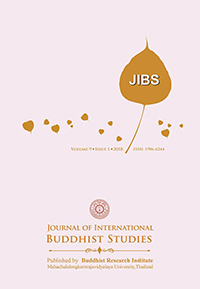Beliefs and Rituals Concerning Buddha Statue in Lan Na
Abstract
The article on “Beliefs and rituals concerning Buddha-statue in Lān Nā” aims to study the beliefs and rituals concerning Buddha-statue in Lān Nā. This is a documentary research which composed of in-depth interviews with local scholars in the eight northern provinces. The data were analyzed and presented in descriptive way. The study found that the belief is the emotion of all persons, irrespective of intelligence. The cause of belief is ignorance and fear and it is the most powerful. In Buddhism, the word belief is translated from Pālī word “Saddhā” which also means confidence or trust. Belief has another word that has close meaning, that is, “Pasāda” which means luminous joy and sometimes both of them have been used together as Saddhāpasāda which means belief with luminous joy. The sources of luminous joy can be divided into four, they are, admiring body, lovely sound, gloomy uniform and Dhamma. When people have trusted in anyone, they will treat that one with respect. Such practice is considered a ritual. And when ritual has been practiced for a long time, it will become a tradition. In the religious point of view, the ritual can be compare to barks of the tree. Generally, people will have beliefs and adhere to something concrete or connected with supernatural power or holy things. Such people are majority in the society. For them, ritual are the major practice of social life. Those who have a chance to hear the Dhamma and see the truth, their ignorant belief will be reduced and, more rational, will be used as the sapwood which is the initiation of the wood, which after some time, it will became a staple wood. Buddha-statue is created as Buddha’s representative, the one that devoted to the Buddha is called Uddesikachedī, one out of four Buddhist Chedīs, they are, Dhātuchedī, Paribhogachedī, Dhammachedī and Uddesikachedī. Buddha-statue hold the most important part to the lives and thoughts of Buddhists, despite of being created by various materials such as clay, bricks, concrete, stone, brass, copper or gold in different size, small or big one. The importance of the Buddha-statue derives from belief and base on that the ritualistic practice follows. The belief in Buddha-statue can be divided into two categories; (1) the belief that Buddha-statue is a living thing such as ordinary man. This leads to the ritual of face-cleansing, offering rice porridge, offering the new grain, offering yellow robe, offering firewood, offering light, offering water ablutions, and the ritual of celebration for becoming Buddha and the fireballs. And (2) the belief that Buddha-statue is omnipotent, which leads to the ritual of asking for rain, cooking holy rice and ritual for auspicious boon etc. Although belief is a private matter for each individual, when it turns into practice, and was accepted for longer period, it will became tradition, and as long as those beliefs and rituals are not harmful to individuals and society, they will be practiced continuously.
References
Arunrat vichiankhiaw. Buddha-statue in LanNa. Chiang Mai: Tawanneu Publishing, 2554.
Buddhakama. Tamnanmulasasana. Chiang Mai: 2513.
Cultural Encyclopedia of Northern Thailand. Bangkok: Thai Cultural Encyclopedia Foundation. Thaipanich Bank of Thailand, 2542.
Fine Arts Department. Important Buddha-statue. Bangkok: Department of Arts, 2545.
Kingkeaw Atthakorn. Folklore. Document No. 184. Supervision Department of Teacher Education. Ministry of Education, 2519.
Kittiya Udavi. The beliefs and values of making a bronze Buddha-statue in LanNa. 2550.
Khian Yimsiri. Buddhanusorn. Bangkok: Boonsong Printing, 2500.
Mahachulalongkornrajavidyalaya. Tipitaka. Bangkok : 2539.
Phrakru-adulsilakitti. Lanna rituals. Chiang Mai : Doi Suthep Foundation, 2551.
Phrabodhirangsri. The Chamadevivamsa. Bangkok: Sripanna, 2554. Phrayadamrongrajanupab. The Legend of pagoda. Bangkok:
Sa-ngeun Chotisukharat.. The legend of LanNa. Bangkok: Odeon Store, 2515.
Saeng Chandra-ngarm. Theology. Bangkok: Thaiwattanapanich, 2545.
English version
John E.Conklin. Sociology An Introduction. Macmillan Publishing Co.,Inc.,New York. 1984.
Mavis Hiltunen and John Biesanz. Introduction to Sociology.
(third edition) Englewood Cliffs. New Jersey : Prentice-Hall, Inc. 1978.
Popeonoe.David. Sociology. Englewood Cliffs. New Jersey : Prentice-Hall, Inc. 1980.
Gangvidya Publishers, 2517.
Interview
Phrakru-anurakpariyattigun. Watphapha, Sobmai district,
Meahongsorn province.
Phrakru-adulsilakitti. WatDhatkam, Meung, Chiang Mai province. Phrakrusirisutaphimon. Watdungheuchang, Lumphun province.







